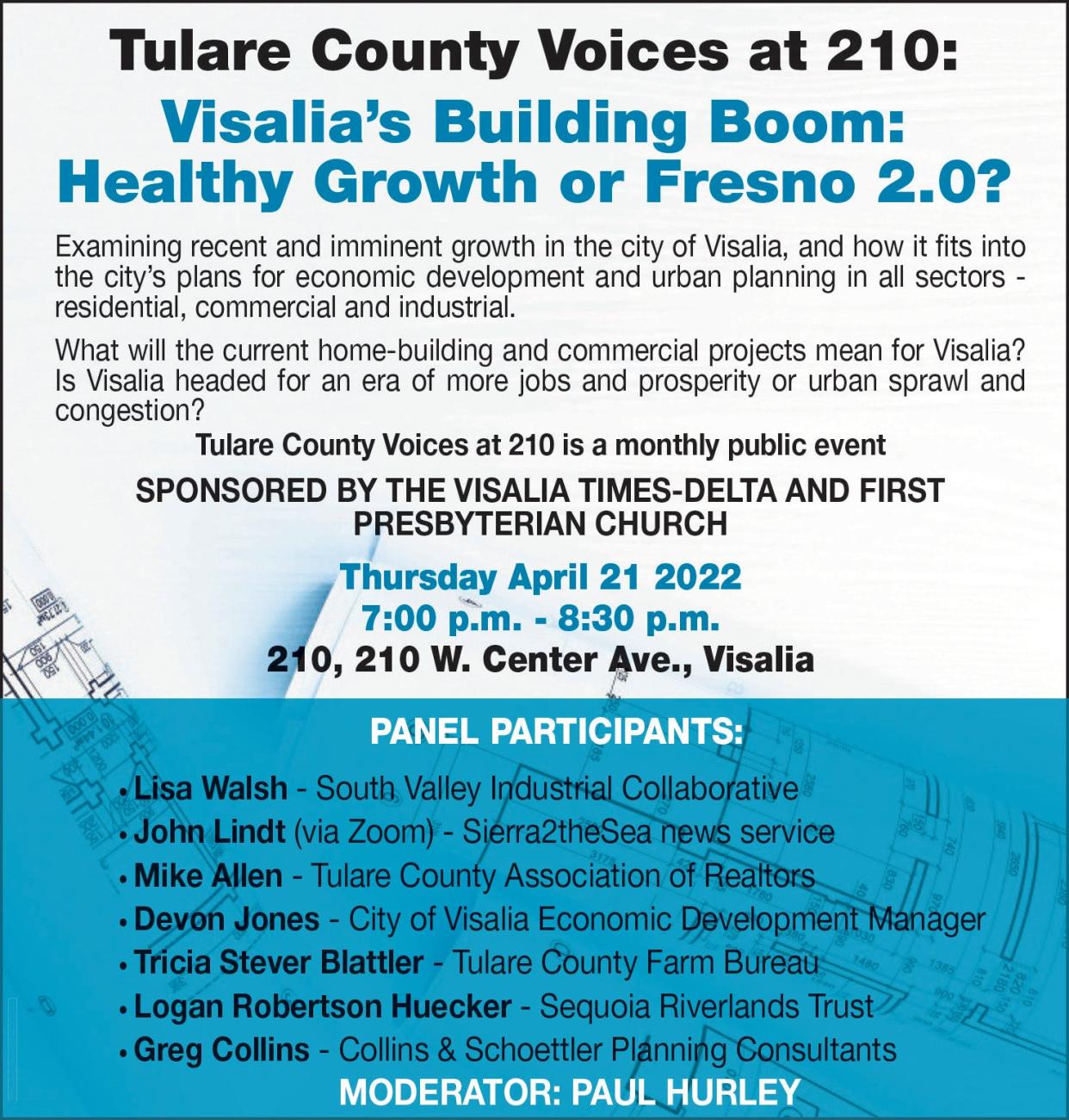Can Visalia keep up with economic, building boom? Local experts weigh in

Visalia is emerging from the restraints of the COVID-19 pandemic in more ways than one, including building growth.
Visalians can notice signs of a new building boom all over the city, with new homes, commercial projects and industrial space rising everywhere.
The growth boomlet presents its own challenges, putting stress on competing interests of agriculture, real estate, business and resources, such as water.
Tulare County Voices @210, the monthly forum co-sponsored by the Visalia Times-Delta and First Presbyterian Church, will attempt to make sense of the city's growth spurt. "Visalia's Building Boom: Healthy Growth or Fresno 2.0?" will be at 7 p.m. on Thursday at 210, 210 W. Center Avenue in Visalia.
This event is free and open to the public. Doors open at 6:15 p.m.
Agreeing to join a panel to discuss Visalia's recent growth is a group of interested parties from a wide range of interests:
Mike Allen - Tulare County Association of Realtors
Greg Collins - Collins & Schoettler Planning Consultants
John Lindt (via Zoom) - Sierra2theSea news service
Logan Robertson Huecker - Sequoia Riverlands Trust
Tricia Stever Blattler - Tulare County Farm Bureau
Lisa Walsh - South Valley Industrial Collaborative
Recent reporting by John Lindt has focused on Visalia's building boom, including the approval of 2 million square feet of new warehouse space in Visalia's industrial park. According to Lindt, Visalia also saw a 14% increase in sales tax income in fiscal year 2020-21, a substantial 6% increase in property tax income and an unexpected 22% increase in hotel tax revenue.
Some of that increase can be attributed to the fact that most forms of economic activity — including tourism, travel, dining and new construction — were put on hold for nearly two years because of the pandemic.
But Visalia is coming out of it with a strong surge. The Visalia Chamber of Commerce newsletter earlier this month noted that the 2,751 permits issued for housing additions and alterations in 2021 was the most in the city's history. Visalia last year also had 636 new single-family homes with 204 new multi-family units, the most multi-family units approved in one year since 2007.
It also noted the construction of two new hotels in Visalia, and the imminent completion of a project west of Plaza Drive that includes 2.6 million square feet of warehouse space.
One of the highest profile projects is the Sequoia Gateway center at Caldwell Avenue and Highway 99. Valley Children's Hospital has announced plans for a clinic at the site. But causing the most buzz is the report of inclusion of a Great Wolf Lodge, a combination lodging and entertainment complex with 700 rooms, which would make it Visalia's largest hotel.
As Visalia Chamber of Commerce President and CEO Gail Zurek observed in a message to members this month, that kind of economic activity is a stimulus to business, including retail shopping and services. Zurek is confident that growth can be managed to the benefit of the entire community.
More: Visalia Civic Center price tag triples to $70M
"The market moves at a rapid pace," Zurek wrote in the Chamber's April newsletter. "Visalia is a fantastic place to raise a family and own a business. To continue, we must move at the pace of the market, accept innovation and band together as businesses to continue defining and redefining what makes us the gem of the Central Valley."
Zurek identifies the key challenge in embracing growth: How does a community plan properly so as to best incorporate new business, more homes and people, and more demands on crucial services such as water and infrastructure?
Lisa Walsh is in a unique position to comment on the question. She is chairman of the Visalia Economic Development Corporation (VEDC) and serves on the board of the South Valley Industrial Collaborative. As the manager of Hydrite Chemical in Visalia, she sees firsthand the growth of the industrial park and recognizes its challenges.
Walsh trusts that Visalia's reputation for prudent planning will continue to be a community asset.
"With recent bolstering of our planning department," she said, "a well established general plan that includes land use tiering, continued collaboration with industrial developers, utilities, educators, community members and employers, we will be able to support and collectively promote industrial development."
Visalia's growth spurt puts pressure on many features of the Valley's environment, perhaps none more than its lifeblood and economic engine: agriculture. As executive director of Tulare County Farm Bureau, Tricia Stever Blattler expresses the concern of farmers about the pressure from urban growth on the Valley's water.
More: Amid worsening California drought, Visalia restricts water use
“Visalia, like all other cities in critically over drafted sub-basins, will be required to adhere to the GSA’s (Groundwater Sustainability Agency) sustainability plan," Stever Blattler said. "Our region is facing a dire situation this summer, with the full implementation of SGMA (Sustainable Groundwater Management Act), cities, farms and rural communities are all under immense pressure to reduce their reliance on groundwater pumping."
Stever Blattler went on to note how difficult it will be to comply with new requirements about pumping groundwater, whether on the farm or in the city.
"Agriculture is looking at a very bleak picture; most GSAs are suggesting a cut back to less than one acre/foot per acre of land,” she said.
This article originally appeared on Visalia Times-Delta: Visalia's emerging building growth to be analyzed at monthly forum

